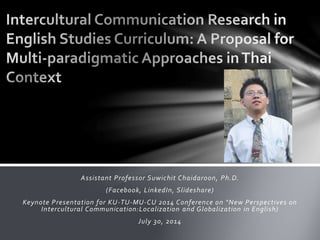Keynote Presentation for KU-TU-MU-CU 2014 Conference on Intercultural Communication
- 1. Assistant Professor Suwichit Chaidaroon, Ph.D. (Facebook, LinkedIn, ║▌║▌▀Żshare) Keynote Presentation for KU-TU-MU-CU 2014 Conference on ŌĆ£New Perspectives on Intercultural Communication:Localization and Globalization in English) July 30, 2014
- 2. The Asian DifferenceŌĆ” Europe (Malta) Thailand
- 3. Outsourced
- 5. Upward Dissent ŌĆó Solution presentation ŌĆó Direct-factual appeal ŌĆó Circumvention ŌĆó Threatening resignation ŌĆó Repetition Organizational Culture (Employees) Tan, Y., Seow, Y. N., Chia, H., Kim, H. J., & Chaidaroon, S. S. (2012) Differences in perceived effectiveness of upward dissent strategies between employees and managers: Evidence from Singapore. Proceedings for the Corporate Communication Institute Conference, New York, USA.
- 6. H1: Employees will perceive solution presentation strategy as the most effective upward dissent strategy H2: Employees will perceive threatening resignation strategy as the least effective upward dissent strategy. Hypotheses
- 7. Results- EmployeeŌĆÖs perceived effectiveness of four different upward dissent strategies 0 1 2 3 4 5 6 7 Solution Presentation Strategy Threatening Resignation Strategy Direct-factual Appeal Strategy Circumvention Strategy Scenario 1 Scenario 2 Scenario 3 5.17 4.36 5.74 4.25
- 8. 0 1 2 3 4 5 6 7 Solution Presentation Strategy Threatening Resignation Strategy Direct-factual Appeal Strategy Circumvention Strategy Scenario 1 Scenario 2 Scenario 3 Results- ManagerŌĆÖs perceived effectiveness of four different upward dissent strategies 3.54 3.49 3.51 3.30 2.61
- 9. ŌĆó IndividualismVS Collectivism ŌĆó Power Distance ŌĆó Uncertainty Avoidance ŌĆó Task Orientation vs. Social Orientation ŌĆó Short-Term Orientation vs. Long-Term Orientation HofstedeŌĆÖs Model (geert-hofstede.com)
- 11. ThailandVS China
- 12. Knutson,T. J., Komolsevin, R., Chatiketu, P., & Smith,V. R. (2002). Comparison of Thai and U.S. American willingness to communicate. Journal of Intercultural Communication Research, 31(1), 3-12. Knutson,T. J., Komolsevin, R., Chatiketu, P., & Smith,V. R. (2003). A cross- cultural comparison of Thai and US American rhetorical sensitivity: Implications for intercultural communication effectiveness. International Journal of Intercultural Relations, 27, 63-78. Komin, S. (1990). Culture and work related-values in Thai organization. International Journal of Psychology, 25, 681-704. Sriussadaporn-Charoenngam, N., & Jablin, F. M. (1999). An exploratory study of communication competence in Thai organizations. The Journal of Business Communication, 36, 382-418. Suggested Readings from Positivistic Paradigm
- 13. Ethnography In Situ Observation Speech Community
- 14. What does ŌĆ£yesŌĆØ mean inThai?
- 16. Chaidaroon, S. S., & Mak, A. K.Y. (2012). Engaging local stakeholders in CSR efforts: Perspective of MNCs in Asian developing countries. Paper presented at the Annual Australian and New Zealand Academy of Management Conference, Perth, WA. Chaidaroon, S. S., & Polyorat, K. (2013). CSR and stakeholder dialogue: A case study of sugar cane company in Thailand. International Journal of Business and Social Research, 3(8). 57-65. CSR & Marketing Communications
- 17. Findings Farmers Company Present metaphor Merchant Spoiled kids Ideal metaphor Clinic (Doctors) Community (Citizens)
- 18. Dialectical Model of CSR
- 19. Chaidaroon, S. S. (2003). When shyness is not incompetence: A case of Thai communication competence. Journal of Intercultural Communication Studies, 12(4), 195-208. Philipsen, G. (1992). Speaking culturally: Explorations in Social Communication. Albany, NY: State University of NewYork Press. Suggested Readings from Ethnographic Approach
- 20. Tensions Negotiation Power Underlying Assumption
- 21. Can Can Can ma Can leh Singapore & Singlish
- 22. A: Can? B: Can A: Can ma? B: Can leh Singapore & Singlish
- 24. Chaidaroon, S. S., & Mak, A. K. Y. (2013). Cultural perspective on social entrepreneurship: A case study of social media usage by a community-based cancer treatment center in rural Thailand. In C. Wankel & L. Pate (Eds.), Social Entrepreneurship as a Catalyst for Social Change (pp. 87-116). Charlotte, NC: Information Age Publishing.
- 25. Identifying Prejudice & Calling for Empathy
- 26. The Aunties ŌĆ£ÓĖĪÓĖÖÓĖĖÓĖ®ÓĖóÓ╣īÓĖøÓ╣ē ÓĖ▓ŌĆØ Phenomenon Redefining the notion of ŌĆ£cultureŌĆØ
- 27. Re-conceptualizing the notion of identity
- 28. Nakayama, T. K., & Halualani, R. T. (Eds.) (2010). The handbook of critical intercultural communication. Malden, MA: Wiley-Blackwell Suggested Readings for Critical Approach
- 29. Strengths Challenges Positivistic Research Provide basic foundations of cross-cultural differences May perpetuate stereotypes Interpretive Research Is compatible with language studies given the nature of methodology In-situ observation may not be practical in certain circumstances Critical Research Allows researchers to critically examine unexplored social issues pertaining to the broader notion of culture Requires advanced language and analytical skills Summary of Intercultural Communication Research Paradigms in English Language Studies





























